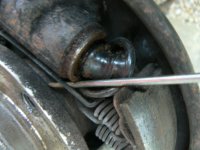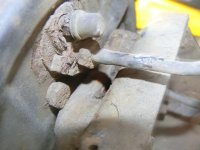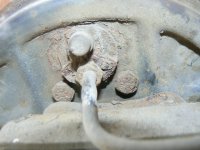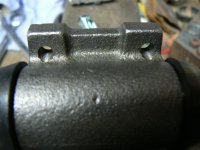Since we bought Becky (2010 Panda 1.2 Dynamic Eco - for the few of you who don't know) I've been gradually working my way through the small list of "things to do". Timing belt, big service, front brakes, etc, etc all done. During the service (some time ago now) I noticed the rear cylinders were "damp" under their dust rubbers, on both sides. I bought two new cylinders the next day but they've just sat in my spares box waiting for me to get round to it! Having just (unexpectedly) had to replace the front struts I took the opportunity to pop the rear drums off and have a closer look at these brake cylinders. The dampness has now progressed to what could legitimately be called a leak - no wetness outside the rubbers yet though - also there is corrosion which makes both rear facing pistons "sticky" in the bores - The return springs are now only just managing to overcome this.

So definitely time to do something about them. In fact this is the last "serious" thing I know of that needs "fixing" - well Ok, there's always that rear axle - so the light is visible at the end of the tunnel.
Closer inspection shows heavy corrosion of the small fixing set screws and tube nut.

I've read about how much of a problem the tube nut/brake pipe can be and I'm prepared to make a new pipe if needed. Likewise with the securing (6mm?) set screws which look as if they are likely to sheer so I am quite expecting to have to renew them (got new ones already) but what I hadn't realised is that the rear most screw is partly blocked by the end of the axle itself so you can't get a socket or even a split ring key on it

I've looked on you tube and come across the Bodgit and Leggit chaps who did it by removing the backplate from the hub to give access.
The backplate is secured by some small Allen screws though and if they round off/strip/snap then I'm just giving myself even more problems so I'd rather not do this. Their back plate and cylinder didn't look half as corroded as mine and yet they thought to mention this as a possible problem. So, today I popped into Kenny Harrison's Garage, feeling just a little nervous that once again I was asking advice without handing over any money, and asked how they did them. I was greeted by my first name an wasn't made to feel a nuisance at all. The advice was to try the conventional approach first - lots of releasing fluid, some gentle tapping and spannering. If that doesn't work make "nicks" with an angle grinder in the lugs of the cylinder casting where the holding screws are and then hit them with a cold chizel. Bits of these lugs can be easily knocked off - Apparently - the casting, cast iron on mine but some are ally, is brittle so bits can be broken off so releasing the screws enough to be able to turn them. I've never thought to try this but I like the idea. You can see how "vulnerable" these lugs are here in this picture of the new cylinder. I was deeply touched when, as I was walking down the road away from the garage, maybe 75 yards away, one of the mechanics with whom I'd been talking came running down the road behind me, dragged me back into the workshop and gave me new securing bolts for the cylinder. He wouldn't take a penny for them! You just don't get that sort of thing happening these days do you? My opinion of these chaps has now gone right off the top end of the "Richter" scale!

So my guess is that it might be quite a "neat" solution.
The B & L video also shows a lining which has detached from the shoe due to failure of the adhesive bond. My shoes are looking pretty "ratty".

Lots of corrosion on the metal parts and just generally "tired" linings and, if you look closely, I think there are some signs of bonding failure - quite probably these are the original shoes?

The drums looked really crusty when I bought her and the lips on the inside were so deep that I had an awful time trying to get the drums off (even with handbrake cables totally disconnected). I have a small grinding wheel which goes in my drill which I used to get rid of the lip and then spent a good half hour with a hammer knocking the worst of the crusty corrosion off at that first service, but even so they still look pretty poor.


I think a set of drums and linings to go with the new cylinders will be the way to go. I should have shares in S4p.
Anyone done this job and run into problems? Or got tips they would care to pass on? I'm just off to try a search but I find sometimes I miss things because I didn't use the right words in the search box. So advice from anyone would be most appreciated.
Just to illustrate my ignorance of the internet, is it ok to post the reference to, for instance, the Bogit and Leggit video as I did here? I'm not doing anything wrong either on our forum or in the wider aspect of it all? Also, I like to post illustrations of what I'm doing etc because I think it makes the viewing of the post much more interesting. Is it ok to do this or am I using up too much of the forums photos storage? I just don't know about these sort of things.
regards to all
Jock

So definitely time to do something about them. In fact this is the last "serious" thing I know of that needs "fixing" - well Ok, there's always that rear axle - so the light is visible at the end of the tunnel.
Closer inspection shows heavy corrosion of the small fixing set screws and tube nut.

I've read about how much of a problem the tube nut/brake pipe can be and I'm prepared to make a new pipe if needed. Likewise with the securing (6mm?) set screws which look as if they are likely to sheer so I am quite expecting to have to renew them (got new ones already) but what I hadn't realised is that the rear most screw is partly blocked by the end of the axle itself so you can't get a socket or even a split ring key on it

I've looked on you tube and come across the Bodgit and Leggit chaps who did it by removing the backplate from the hub to give access.
The backplate is secured by some small Allen screws though and if they round off/strip/snap then I'm just giving myself even more problems so I'd rather not do this. Their back plate and cylinder didn't look half as corroded as mine and yet they thought to mention this as a possible problem. So, today I popped into Kenny Harrison's Garage, feeling just a little nervous that once again I was asking advice without handing over any money, and asked how they did them. I was greeted by my first name an wasn't made to feel a nuisance at all. The advice was to try the conventional approach first - lots of releasing fluid, some gentle tapping and spannering. If that doesn't work make "nicks" with an angle grinder in the lugs of the cylinder casting where the holding screws are and then hit them with a cold chizel. Bits of these lugs can be easily knocked off - Apparently - the casting, cast iron on mine but some are ally, is brittle so bits can be broken off so releasing the screws enough to be able to turn them. I've never thought to try this but I like the idea. You can see how "vulnerable" these lugs are here in this picture of the new cylinder. I was deeply touched when, as I was walking down the road away from the garage, maybe 75 yards away, one of the mechanics with whom I'd been talking came running down the road behind me, dragged me back into the workshop and gave me new securing bolts for the cylinder. He wouldn't take a penny for them! You just don't get that sort of thing happening these days do you? My opinion of these chaps has now gone right off the top end of the "Richter" scale!

So my guess is that it might be quite a "neat" solution.
The B & L video also shows a lining which has detached from the shoe due to failure of the adhesive bond. My shoes are looking pretty "ratty".

Lots of corrosion on the metal parts and just generally "tired" linings and, if you look closely, I think there are some signs of bonding failure - quite probably these are the original shoes?

The drums looked really crusty when I bought her and the lips on the inside were so deep that I had an awful time trying to get the drums off (even with handbrake cables totally disconnected). I have a small grinding wheel which goes in my drill which I used to get rid of the lip and then spent a good half hour with a hammer knocking the worst of the crusty corrosion off at that first service, but even so they still look pretty poor.


I think a set of drums and linings to go with the new cylinders will be the way to go. I should have shares in S4p.
Anyone done this job and run into problems? Or got tips they would care to pass on? I'm just off to try a search but I find sometimes I miss things because I didn't use the right words in the search box. So advice from anyone would be most appreciated.
Just to illustrate my ignorance of the internet, is it ok to post the reference to, for instance, the Bogit and Leggit video as I did here? I'm not doing anything wrong either on our forum or in the wider aspect of it all? Also, I like to post illustrations of what I'm doing etc because I think it makes the viewing of the post much more interesting. Is it ok to do this or am I using up too much of the forums photos storage? I just don't know about these sort of things.
regards to all
Jock
Last edited:


